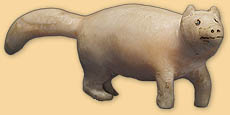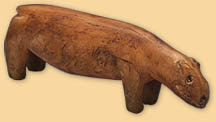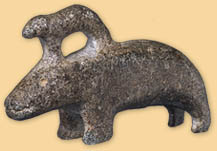 |
Christian Leden, a Norwegian anthropologist, went to Greenland in
1909 to record songs, and there he filmed and photographed Greenland's
Indigenous people. In the process, he learned some rudimentary Inuktitut
which served him well when he undertook a three-year expedition in the
Keewatin along the West Coast of Hudson Bay between 1913 and 1916.
Leden wrote a book about his adventures which was first published
in German in 1927.* In it he describes his method of collecting: "I
go from house to house, pay visits, greet all the inhabitants of the camp,
bargain for anthropological items. The Eskimos wonder what use I can make
of the items I buy. Especially, it is beyond their comprehension how
I come to prefer old, worn articles to new ones."*
He also acknowledges the support he received from the Geological
Survey. "[].. there are a good thousand articles for the
Victoria Memorial in Ottawa. They are in acknowledgement for the help
and support furnished by the Canadian government to my expedition. Its
aid enabled me to prolong my ethnographic work over several years,
despite the loss of most of my equipment in the shipwreck of the
first autumn.**
*Leden, Christian
1990 – Across the Keewatin Icefields. Winnipeg: Watson
and Wyer Publishing Ltd., p. 156.
** Ibid., p. 252.
von Finckenstein, Maria
2004 – "Playthings from the Keewatin." Inuit Art
Quarterly 19(3): tbd.

 |
|
"Angnak – Woman (Plaything)," 1916
Area around Chesterfield Inlet, Nunavut
Stone
5 x 2 x 1.8 cm
CMC IV-C-1195
Collected by Norwegian anthropologist Christian Leden during his expedition
to the Keewatin from 1913 to 1916
|
 |
Christian Leden catalogued his collections carefully, noting each
item's Inuktitut name, the English equivalent, the object's function,
and the name of the cultural group from which he had collected it.
Most small carvings in his collection, which he referred to as
playthings, are meant to be held, rather than to stand. On a
larger scale, this little sculpture could easily be a contemporary
carving from Repulse Bay.
"Terringaniak – Fox (Plaything)," 1916
Area around Chesterfield Inlet, Nunavut
Ivory, black colouring
1.6 x 3.9 x 0.6 cm
CMC IV-C-1419
Collected by Norwegian anthropologist Christian Leden during his
expedition to the Keewatin from 1913 to 1916
|
 |
 |
The fact that Leden asked Inuit for "old, worn" articles
makes his collection especially valuable. It is safe to assume that
this minuscule fox was originally created as a toy for an Inuit child
and not as a barter item.
Despite its tiny size, small enough to be held in a child's hand,
it is crafted with careful detail and appears to be quivering with life.
The cultural group from which he collected it were the Aivillirmiut.
 |
"Nannak – Bear (Plaything)," 1916
Area around Chesterfield Inlet, Nunavut
Musk-ox horn
2.8 x 5.5 x 1.1 cm
CMC IV-C- 984
Collected by Norwegian anthropologist Christian Leden during his
expedition to the Keewatin from 1913 to 1916
|
 |
Musk-ox horn is unusual as a carving material. According to Leden,
he acquired this item from the Kinipetu (also referred to as the
Qaernermiut). It is a plaything – the equivalent to a teddy bear for
an Inuit child.
Exhibition History:
Out There is Somewhere: The Arctic in Pictures. Organized by
the Art Gallery of Windsor. Art Gallery of Windsor, Windsor, Ontario,
March 23 – May 26, 2002; Edmonton Art Gallery, Edmonton, Alberta,
September 6 – November 2, 2002.
Arctic Mirror. Canadian Museum of Civilization, Hull, Quebec
January 25 – September 9, 1990. No catalogue.
References:
Blodgett, Jean
1988 – "The Historic Period in Canadian Eskimo Art" in
Inuit Art: An Anthology. Winnipeg: Watson & Dyer, ill. p. 23.
"Nannok Krittangareiit – Bear with Cub on the Back," 1916
Area around Chesterfield Inlet, Nunavut
Grey stone
3.5 x 5.7 x 1.5 cm
CMC IV-C-1720
Collected by Norwegian anthropologist Christian Leden during his
expedition to the Keewatin from 1913 to 1916
|
 |
 |
Much attention has been given to this miniature bear with its cub,
which Leden collected from the Aivillirmiut. It is of unusual form and
subject matter. The stylistic device of one form flowing into another
predates the sculptures of Tiktak, a Keewatin artist of the
contemporary period.
Exhibition History:
Arctic Mirror. Canadian Museum of Civilization, Hull, Quebec,
January 25 – September 9, 1990. No catalogue
The Coming and Going of the Shaman: Eskimo Shamanism and Art.
Winnipeg Art Gallery, March 11 – July 23, 1978, # 68.
Sculpture/Inuit: Masterworks of the Canadian Arctic.
Organized by the Canadian Eskimo Arts Council. Vancouver Art Gallery,
Vancouver, B.C., November 9 – December 9, 1971; Le Grand Palais, Paris,
France, February 10 – April 2, 1972; Nationalmuseet, Copenhagen, Denmark,
April 26 – May 28, 1972; The Hermitage, Leningrad, Russia, June 29 –
July 23, 1972; Pushkin Fine Arts Museum, Moscow, Russia, August 10 –
September 10, 1972; Burlington Gardens Museum, London, England,
October 5 – December 10, 1972; Philadelphia Museum of Art, Philadelphia,
U.S., January 24 – March 4, 1973; National Gallery of Canada, Ottawa,
May 17 – June 17, 1973.
References:
Blodgett, Jean
1979 – The Coming and Going of the Shaman: Eskimo Shamanism
and Art. Winnipeg Art Gallery, ill. # 68.
Blodgett, Jean
1988 – "The Historic Period in Canadian Eskimo Art" in
Inuit Art: An Anthology. Winnipeg: Watson & Dyer, ill. p. 23.
Canadian Eskimo Arts Council
1971 – Sculpture/Inuit. Exhibition Catalogue. Ottawa:
Canadian Eskimo Arts Council, no. 351.
|